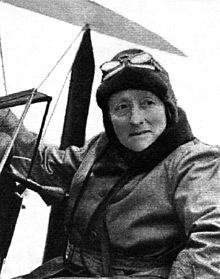- Mary Russell, Duchess of Bedford
-
For other people named Mary Russell, see Mary Russell (disambiguation).
Dame Mary Russell, Duchess of Bedford, DBE, RRC, FLS (26 September 1865 – ca. 22 March 1937) was an English aviatrix and ornithologist.
Contents
Early and personal life
Born as Mary Du Caurroy Tribe at Stockbridge, Hampshire, she was the daughter of Walter Harry Tribe, Anglican Archdeacon of Lahore. On 31 January 1888, she married Lord Herbrand Russell at Barrackpore, India. When Lord Herbrand inherited his childless brother's titles in 1893, she was styled as the Duchess of Bedford.[1]. Her only child, Hastings, was born on 21 December 1888[1].
Work and activism
A major area of organisation and work for the duchess was in founding four hospitals in Woburn and in the grounds of Woburn Abbey. The principal establishment was the Abbey Hospital that she financed and built in 1914, and where she worked as a nurse and radiographer through to the 1930s.[2]
The duchess was a collector and watcher of birds, and took an interest in bird migration. Between 1909 and 1914 she spent much time on Fair Isle, often in the company of William Eagle Clarke. Her journal, A Bird-watcher's Diary, was privately published in 1938 after her death.
She was a member of the Women's Tax Resistance League, a group associated with the Women’s Social and Political Union that used tax resistance to protest the disenfranchisement of women during the British women's suffrage movement.[citation needed]
Honours
She was appointed a Dame Commander of the Order of the British Empire in 1928.[3]She was also Dame of Grace of the Order of Saint John (DGStJ)[1] and a Fellow of the Linnean Society of the Imperial College (FLS)[1].
Aviation
Late in life, the duchess became interested in aviation, that she claimed gave her some relief from her constant tinnitus, although she eventually became totally deaf. On 2 August 1929, she departed on a record-breaking flight of 10,000 miles from Lympne Airport to Karachi (then in India) and return to Croydon Airport in eight days. She was accompanied in her single-engined Fokker F.VII (G-EBTS, named "Spider") by her personal pilot C.D.Barnard and mechanic Robert Little.[4] On 8 April 1930 she made her first solo flight, in her DH.60G Moth (G-AAAO).[5] On 10 April 1930 she embarked on a record-breaking flight from Lympne Airport to Cape Town, in the "Spider", flying 9,000 miles in 100 flying hours over 10 days, accompanied by C.D.Barnard.[6][1]
Death
The duchess died in 1937, aged 71, after leaving Woburn Abbey in a DH.60GIII Moth Major (G-ACUR), that crashed into the North Sea off Great Yarmouth; her body was never recovered.[2][7][8]
See also
Notes
- ^ a b c d e The Peerage.com
- ^ a b Buxton (2008)
- ^ Edinburgh Gazette
- ^ Flight 15 August 1929, flightglobal.com
- ^ Flight 11 April 1930, flightglobal.com
- ^ Flight 25 April 1930, flightglobal.com
- ^ Jackson (1973)
- ^ Flight 1 April 1937, flightglobal.com
References
- Bedford, John Duke of. The Flying Duchess. MacDonald. 1968. ASIN B000RY7R0U
- Buxton, Meriel. The High-Flying Duchess. Woodperry. 2008. ISBN 978-0955892509
- Jackson, A.J. British Civil Aircraft since 1919: Vol 2. Putnam. 1973. ISBN 0370100107
June 03 Emilio Mola
July 02 Amelia Earhart
Nov 16 Sabena OO-AUB Ostend crashIncidents resulting in at least 50 deaths shown in italics. Deadliest incident shown in bold smallcaps.Categories:- 1865 births
- 1937 deaths
- Aviation accidents and incidents in 1937
- Aviators killed in aviation accidents or incidents
- English activists
- English duchesses by marriage
- Dames Commander of the Order of the British Empire
- Dames of Grace of the Order of St John
- English ornithologists
- English tax resisters
- Female aviators
- Members of the Linnean Society of London
- People from Hampshire
- People from Test Valley (district)
- Victims of aviation accidents or incidents in international waters
- Members of the Royal Red Cross
Wikimedia Foundation. 2010.


